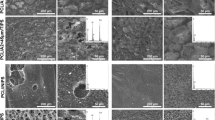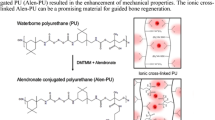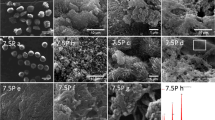Abstract
A novel barrier membrane composed of poly(lactic-co-glycolic acid) particles loaded with dexamethasone (DEX) as a bioactive molecule was produced via a modified nanoprecipitation method without any mixing. The particle membranes had a bilayer structure: one side was smooth and had a compact surface that was connected to larger particles, while the opposite side was rough, porous and connected to smaller particles. Additionally, a cross-section of the particle membrane had a porous structure with nano and micro sized irregular pores. Process optimization revealed that NaCl concentration in the water phase, with acetone as solvent and water as a non-solvent, played critical roles in determining the properties of the particle membranes, such as DEX encapsulation efficiency, thickness and surface morphologies of the particle membranes. A novel barrier membrane containing DEX using polymer particle drug capture technology has been successfully developed.







Similar content being viewed by others
References
Bashutski JD, Wang HL (2009) Periodontal and endodontic regeneration. J Endod 35:321–328
Bilati U, Allémann E, Doelker E (2005) Development of a nanoprecipitation method intended for the entrapment of hydrophilic drugs into nanoparticles. Eur J Pharm Sci 24:67–75
Durucan C, Brown PW (2000) Low temperature formation of calcium deficient hydroxyapatite-PLA/PLGA composites. J Biomed Mater Res 51:717–725
Giteau A, Venier-Julienne MC, Aubet-Pouessel A, Benoit JP (2008) How to achieve sustain and complete protein release from PLGA-based microparticles? Int J Pharm 350:14–26
Hamciuc C, Hamciuc E, Ignat M, Zarnescu G (2009) Aromatic poly(ether imide)s containing nitrile groups. High Perform Polym 21:205–218
Han K, Lee K-D, Gao Z-G, Park J-S (2001) Preparation and evaluation of poly(l-lactic acid) microspheres containing rhEGF for chronic gastric ulcer healing. J Control Release 75:259–269
He J, Feng M, Zhou X, Ma S, Jiang Y, Wang Y, Zhang H (2011) Stabilization and encapsulation of recombinant human erythropoietin into PLGA microspheres using human serum albumin as a stabilizer. Inter J Pharm 4215:69–76
Ju YM, Yu B, West L, Moussy Y, Moussy F (2010) A dexamethasone-loaded PLGA microspheres/collagen scaffold composite for implantable glucose sensors. J Biomed Mater Res 93A:200–210
Kim H, Kim HW, Suh H (2003) Sustained release of ascorbate-2-phosphate and dexamethasone from porous PLGA scaffolds for bone tissue engineering using mesenchymal stem cells. Biomaterials 24:4671–4679
Lee SJ, Park YJ, Park SN, Lee YM, Seol YJ, Ku Y, Chung CP (2001) Molded porous poly (l-lactide) membranes for guided bone regeneration with enhanced effects by controlled growth factor release. J Biomed Mater Res 55:295–303
Lee JM, Kim YS, Kim CW, Han JS (2003) The effect of the bioresorbable collagen membrane on the regeneration of bone defect by using the mixture of autograft and xenograft bone. J Korean Acad Prosthodont 41:325–341
Peltonen L, Aitta J, Hyvönen S, Karjalainen M, Hirvone J (2004) Improvend entrapment efficiency of hydrophilic drug substance during nanoprecipitation of poly(l)lactide nanoparticles. AAPS PharmSciTech 5: Article 16
Puumanen K, Kellomäki M, Ritsilä V, Böhling T, Törmälä P, Waris T, Ashammakhi N (2005) A novel bioabsorbable composite membrane of Polyactive® 71/30 and bioactive glass number 13–93 in repair of experimental maxillary alveolar cleft defects. J Biomed Mater Res B 75B:25–33
Sethuraman VA, Lee MC, Bae YH (2008) A biodegradable pH-sensitive micelle system for targeting acidic solid tumors. Pharm Res 25:657–666
Seung JL, Park YJ, Park SN, Lee YM, Seol YJ, Ku Y, Chung CP (2001) Molded porous poly (l-lactide) membranes for guided bone regeneration with enhanced effects by controlled growth factor release. J Biomed Mater Res 55:295–303
Shameem M, Lee H, DeLuca PP (1999) A short-term (accelerated release) approach to evaluate peptide release from PLGA depot formulations. AAPS PharmSciTech 1:1–6
Son JS, Appleford M, One JL, Wenke JC, Kim JM, Choi SH, Oh DS (2011) Porous hydroxyapatite scaffold with three-dimensional localized drug delivery system using biodegradable microspheres. J Control Release 153:133–140
Talal A, Waheed N, Al-Masri M, Mckay IJ, Tanner KE, Hughes FJ (2009) Absorption and release of protein from hydroxyapatite-polylactic acid (HA-PLA) membhranes. J Dent 37:820–826
Xiao Y, Peperzak V, van Rijn L, Borst J, de Bruijn JD (2010) Dexamethasone treatment during the expansion phase maintains stemness of bone marrow mesenchymal stem cells. J Tissue Eng Regen Med 4:374–386
Yoo HS, Choi HK, Park TG (2001) Protein–fatty acid complex for enhanced loading and stability within biodegradable nanoparticles. J Pharm Sci 90:194–201
Zhou X, He J, Zhou Z, Ma S, Jiang Y, Wang Y (2010) Effect of NaCl in outer water phase on the characteristics of BSA-loaded PLGA sustained-release microspheres fabricated by a solid-in-oil-in-water emulsion technique. Acta Pharmacol Sin 45:1057–1063
Acknowledgment
This research was supported by the National Research Foundation of Korea (NRF) funded by the Ministry of Education, Science and Technology (No.R13-2008-010-00000-0).
Author information
Authors and Affiliations
Corresponding author
Rights and permissions
About this article
Cite this article
Son, JS., Kim, SG., Jin, SC. et al. Development and structure of a novel barrier membrane composed of drug-loaded poly(lactic-co-glycolic acid) particles for guided bone regeneration. Biotechnol Lett 34, 779–787 (2012). https://doi.org/10.1007/s10529-011-0819-x
Received:
Accepted:
Published:
Issue Date:
DOI: https://doi.org/10.1007/s10529-011-0819-x




